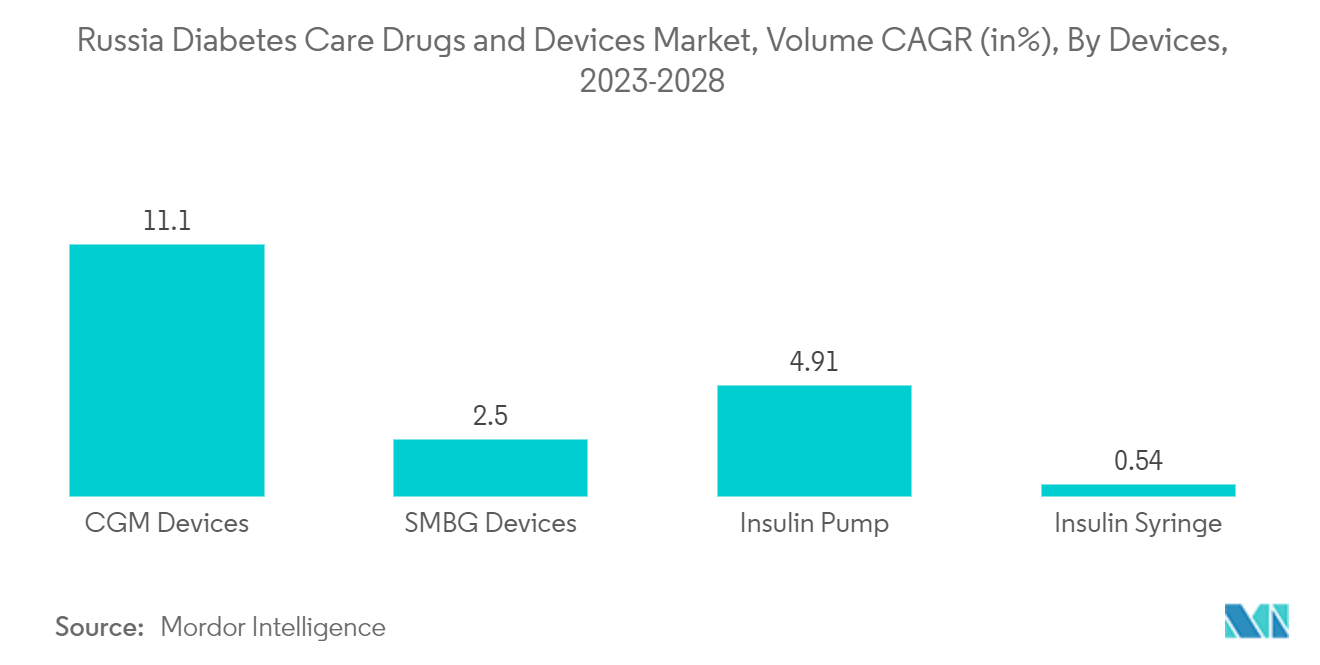Market Trends of Russia Diabetes Drugs and Devices Industry
The continuous Glucose Monitoring Segment is Expected to Witness the Highest Growth Rate Over the Forecast Period
The continuous blood glucose monitoring segment is expected to register a CAGR of around 15.05% during the forecast period.
A continuous blood glucose monitor is an automatic blood glucose monitoring system consisting of a small device worn on the body and attached with an adhesive patch. The sensor portion of the device includes a cannula inserted into the top layer of the skin and uses a sample of interstitial fluid to check blood sugar levels. The sensor is connected to a transmitter that can transmit data wirelessly to a particular mobile receiving device or smartphone. For diabetics, their caregivers, and the community, her use of CGM is beneficial in managing blood sugar and insulin levels to maintain good health. CGM makes blood sugar control much more accessible by reducing interruptions and allowing for better sleep. It also improves the mental health of patients and caregivers by reducing the overall mental burden associated with diabetes management.
Continuous blood glucose monitoring has become a popular alternative to commercially available portable finger glucose meters for people with diabetes. The sensor is the most important part of any continuous blood glucose monitoring device. Various promising glucose sensor technologies are being developed, ranging from traditional electrochemical glucose sensors to new optical and other electrical glucose sensors, positively impacting the market growth. Continuous blood glucose monitoring sensors have opened new scenarios for offline assessment of the efficacy of treatment regimens for individual patients, facilitating the development of innovative online applications. This includes a hypoglycemia\/hyperglycemia warning system and an artificial pancreas control algorithm. With new technologies, continuous blood glucose monitoring devices are becoming increasingly inexpensive.
Market opportunities for players in the Russian diabetes drugs and devices market include numerous new product launches, increased international research collaboration for technological advances, and increased public awareness of diabetes.

Rising diabetes prevalence
There has been an alarming increase in the prevalence of diabetes in Russia in recent years. A diabetic need several corrections throughout her day to maintain nominal blood sugar levels, including Oral antidiabetic drugs, or monitor blood sugar and take additional carbohydrates. It has been observed that the rate of new diagnoses of type 1 and type 2 diabetes is increasing, mainly due to obesity, unhealthy diet, and lack of exercise.
Various efforts have been started to fight diabetes in Russia. For example, at the 2021 Moscow City Forum, a memorandum of understanding was signed between the Youth Council of the Ministry of Health of Moscow, the Moscow City Forum, the Moscow Diabetes Association, the Medical Department of the Moscow Diabetes Association, KB Strelka, and Novo. Nordisk implements Urban Modified Diabetes Program in Moscow. The Moscow program aims to comprehensively assess the characteristics of diabetes challenges relevant to Moscow. The program has also developed an action plan to combat the disease in the most vulnerable populations.
According to the IDF, the Russian government needs to fully implement the National Diabetes Plan to stem the spread of diabetes in the country. This plan provides a state budget to ensure diabetes treatment for all Russian citizens. Russia is working to improve its reimbursement system for all aspects of diabetes care to limit out-of-pocket costs and prevent devastating household expenditures. In addition, a national screening program for improved early detection of carbohydrate metabolism disorders was introduced, and a specialized diabetes health service was established under the Ministry of Health of the Russian Federation.
The increasing diabetes prevalence and the above factors will likely drive the segment growth over the forecast period.


